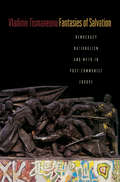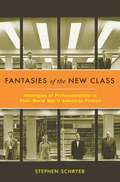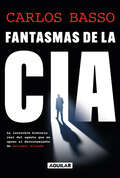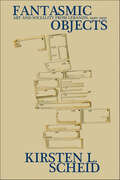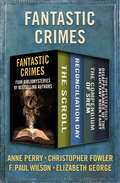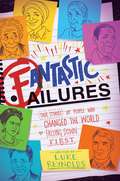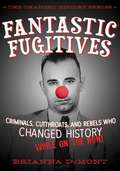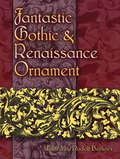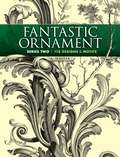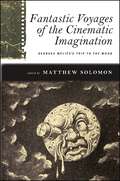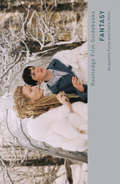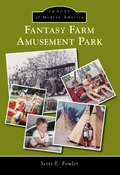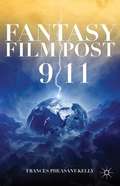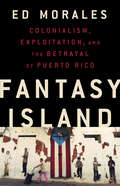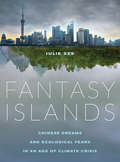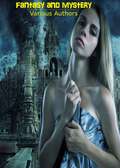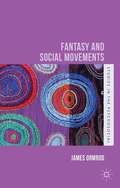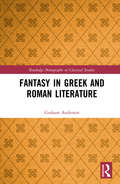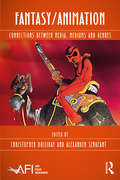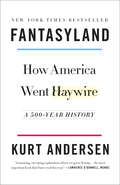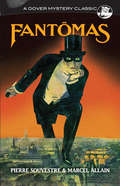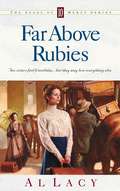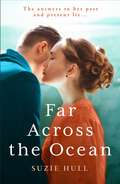- Table View
- List View
Fantasies of Salvation: Democracy, Nationalism, and Myth in Post-Communist Europe
by Vladimir TismaneanuEastern Europe has become an ideological battleground since the collapse of the Soviet Union, with liberals and authoritarians struggling to seize the ground lost by Marxism. In Fantasies of Salvation, Vladimir Tismaneanu traces the intellectual history of this struggle and warns that authoritarian nationalists pose a serious threat to democratic forces. A leading observer of the often baffling world of post-Communist Europe, Tismaneanu shows that extreme nationalistic and authoritarian thought has been influential in Eastern Europe for much of this century, while liberalism has only shallow historical roots. Despite democratic successes in places such as the Czech Republic and Poland, he argues, it would be a mistake for the West to assume that liberalism will always triumph. He backs this argument by showing how nationalist intellectuals have encouraged ethnic hatred in such countries as Russia, Romania, and the former Yugoslavia by reviving patriotic myths of heroes, scapegoats, and historical injustices. And he shows how enthusiastically these myths have been welcomed by people desperate for some form of "salvation" from political and economic uncertainty. On a theoretical level, Tismaneanu challenges the common ideas that the ideological struggle is between "right" and "left" or between "nationalists" and "internationalists." In a careful analysis of the conflict's ideological roots, he argues that it is more useful and historically accurate to view the struggle as between those who embrace the individualist traditions of the Enlightenment and those who reject them. Tismaneanu himself has been active in the intellectual battles he describes, particularly in his native Romania, and makes insightful use of interviews with key members of the dissident movements of the 1970s and 1980s. He offers original observations of countries from the Baltic to the Black Sea and expresses his ideas in a vivid and forceful style. Fantasies of Salvation is an indispensable book for both academic and nonacademic readers who wish to understand the forces shaping one of the world's most important and unpredictable regions.
Fantasies of the New Class: Ideologies of Professionalism in Post–World War II American Fiction
by Stephen SchryerAmerica's post–World War II prosperity created a boom in higher education, expanding the number of university-educated readers and making a new literary politics possible. Writers began to direct their work toward the growing professional class, and the American public in turn became more open to literary culture. This relationship imbued fiction with a new social and cultural import, allowing authors to envision themselves as unique cultural educators. It also changed the nature of literary representation: writers came to depict social reality as a tissue of ideas produced by knowledge elites.Linking literary and historical trends, Stephen Schryer underscores the exalted fantasies that arose from postwar American writers' new sense of their cultural mission. Hoping to transform capitalism from within, writers and critics tried to cultivate aesthetically attuned professionals who could disrupt the narrow materialism of the bourgeoisie. Reading Don DeLillo, Marge Piercy, Mary McCarthy, Saul Bellow, Ursula K. Le Guin, Ralph Ellison, and Lionel Trilling, among others, Schryer unravels the postwar idea of American literature as a vehicle for instruction, while highlighting both the promise and flaws inherent in this vision.
Fantasmas de la CIA
by Carlos Basso PrietoLa increíble historia real del agente de la CIA que se opuso al derrocamiento de Allende. En septiembre de 1970 en la Casa Blanca una reunión entre el presidente de Estados Unidos Richard Nixon y el jefe de la CIA sellaron el destino de Chile: había que evitar a cualquier costo que el socialista Salvador Allende llegara a la presidencia del país. Para ellos, decidieron crear una fuerza especial y enviaron a dos agentes que hablaban español, tenían una nutrida experiencia en espionaje y habían participado en varias operaciones de ese tipo. Henry Hecksher y David Atlee Phillips. El primero era el jefe de la CIA en Santiago en ese momento y el segundo era un agente que había sido reclutado como tal en 1950, cuando vivía en la capital chilena. Ambos fueron protagonistas de múltiples acontecimientos de la Guerra Fría: el golpe de Estado de Guatemala, la invasión de Bahía de Cochinos y los intentos por matar a Fidel Castro, la muerte de John F. Kennedy y el viaje de Lee Harvey Oswald a México, así como un intento de asesinar a Allende. Incluso un fallido golpe de Estado que la CIA intentó dar en Chile en 1970. Partieron como amigos y terminaron enfrentándose. Porque uno de ellos se opuso a la idea de derrocar a Allende, lo que destruyó su carrera y hasta hoy su nombre no puede pronunciarse en los pasillos de la CIA.
Fantasmic Objects: Art and Sociality from Lebanon, 1920–1950 (Public Cultures Of The Middle East And North Africa Ser.)
by Kirsten L. ScheidIn Lebanon, the study of modern art—rather than power or hierarchy—has compelled citizens to confront how they define themselves as a postcolonial nation.In Fantasmic Objects, Kirsten L. Scheid offers a striking study of both modern art in Lebanon and modern Lebanon through art. By focusing on the careers of Moustapha Farrouk and Omar Onsi, forefathers of an iconic national repertoire, and their rebellious student Saloua Raouda Choucair, founder of an antirepresentational, participatory art, Scheid traces an emerging sense of what it means to be Lebanese through the evolution of new exhibition, pedagogical, and art-writing practices. She reveals that art and artists helped found the nation during French occupation, as the formal qualities and international exhibitions of nudes and landscapes in the 1930s crystallized notions of modern masculinity, patriotic femininity, non-sectarian religiosity, and citizenship. Examining the efforts of painters, sculptors, and activists in Lebanon who fiercely upheld aesthetic development and battled for new forms of political being, Fantasmic Objects offers an insightful approach to the history and formation of modern Lebanon.
Fantastic Crimes: Four Bibliomysteries by Bestselling Authors (Bibliomysteries)
by F. Paul Wilson Elizabeth George Christopher Fowler Anne PerryBook-centered mystery novellas from four masters of the craft. From Anne Perry, the New York Times–bestselling author of the Charlotte and Thomas Pitt series, comes The Scroll. Hapless bookseller Monty Danforth&’s recent discovery of a millennia-old manuscript plunges him into a cutthroat conspiracy. &“A master storyteller.&” —The Star-Ledger Christopher Fowler, author of the Bryant and May mysteries, presents Reconciliation Day. One man&’s obsession with a lost edition of Bram Stoker&’s Dracula sends him on a dangerous journey to Transylvania. &“If Edgar Allan Poe and Monty Python had lived in the same country and the same century and somehow struck up a creative collaboration, their work might have resulted in fiction similar to Fowler&’s.&” —Richmond Times-Dispatch From F. Paul Wilson, the New York Times–bestselling creator of Repairman Jack, comes The Compendium of Srem. Prior Tomás de Torquemada yields the ultimate power, deciding who lives and dies during the Spanish Inquisition, but an ancient, evil tome is about to change that. &“A great storyteller and a thoughtful one.&” —David Morrell, New York Times–bestselling author of First Blood Elizabeth George, the New York Times–bestselling author of the Inspector Lynley novels, brings you The Mysterious Disappearance of the Reluctant Book Fairy. A woman&’s gift for immersing herself in the plot of whatever book she likes draws overwhelming fame—and misfortune. &“An essential writer of popular fiction today.&” —The Washington Post
Fantastic Failures: True Stories of People Who Changed the World by Falling Down First
by Luke ReynoldsEven the most well-known people have struggled to succeed! Find out what they learned and how they turned their failures into triumphs with this engaging and youthful guide on how to succeed long term. <P><P>There is a lot of pressure in today’s society to succeed, but failing is a part of learning how to be a successful person. In his teaching career, Luke Reynolds saw the stress and anxiety his students suffered over grades, fitting in, and getting things right the first time. <P><P>Fantastic Failures helps students learn that their mistakes and failures do not define their whole lives, but help them grow into their potential. Kids will love learning about some of the well-known people who failed before succeeding and will come to understand that failure is a large component of success. <P><P>With stories from people like J. K. Rowling, Albert Einstein, Rosa Parks, Sonia Sotomayor, Vincent Van Gogh, Julia Child, Steven Spielberg, and Betsy Johnson, each profile proves that the greatest mistakes and flops can turn into something amazing. Intermixed throughout the fun profiles, Reynolds spotlights great inventors and scientists who discovered and created some of the most important medicines, devices, and concepts of all time, including lifesaving vaccines and medicines that were stumbled upon by mistake.
Fantastic Fugitives: Criminals, Cutthroats, and Rebels Who Changed History While on the Run! (The Changed History Series)
by Brianna DumontThroughout history--and even today--the head honchos usually like things the way they are. Rocking the boat does not make them happy--not one bit. They may even want your head for going against the grain. But that threat didn’t stop the characters spotlighted in Fantastic Fugitives from changing history. They founded countries, won wars, and even ended empires--all while on the run! History’s Most Wanted covered in this book include: Spartacus Martin Luther Harriet Tubman John Dillinger Emmeline Pankhurst Nelson Mandela And six more! The exciting second book in the Changed History series, Fantastic Fugitives lets you follow these historical figures’ fast-paced stories to learn how anyone can change the world. Even you! Just make sure you have your running shoes on. This book is ideal for kids ages 8 and up, and is especially good for reluctant readers and those kids who think history reading is simply dry and boring. There are many color illustrations, photographs, and maps included through the book and sidebars with fascinating facts break up larger chunks of text in each chapter. Teachers, librarians, and parents will like that this can be used as a good go-to book to inspire kids to become interested in history.
Fantastic Gothic and Renaissance Ornament
by Rudolf BerlinerAn Archive of Spectacular ImagesSpotlighting Pivotal Designs in the History of Western ArtDancing beasts of myth and legend, thick foliage that appears to live and breathe, reclining figures engulfed by symbols of fate--this magnificent compendium of 15th- and 18th-century embellishments offers up a dizzying array of Gothic and Renaissance designs steeped in religion and fantasy. A marvel of art history, 127 exquisitely rendered black-and-white illustrations will thrill students and art aficionados, and serve as a rich source of inspiration for anyone working in the fine or applied arts.
Fantastic Ornament, Series Two: 118 Designs and Motifs (Dover Pictorial Archive)
by A. HauserEngraved in the 19th century, these flamboyant ornamental designs are based on a wide variety of historical examples, dating back as far as the 1500s and including images by Watteau and Dürer. Created as embellishments for walls, arms and armor, and everyday objects, these designs remain eminently useful for graphic and decorative purposes.
Fantastic Tales
by Iginio Ugo TarchettiLawrence Venuti, winner of a Guggenheim fellowship and the Global Humanities Translation Prize, among many other awards, has translated into English these Italian Gothic tales of obsessive love, mysterious phobias, and the hellish curse of everlasting life.In this collection of nine eerie stories, Iginio Ugo Tarchetti switches effortlessly between the macabre and the breezily comical. Set in nineteenth-century Italy, his characters court spirits and blend in with the undead: passionate romances filled with jealousy and devotion are fueled by magic elixirs. Time becomes fluid as characters travel between centuries, chasing affairs that never quite prosper. First published by Mercury House in 1992.
Fantastic Voyages of the Cinematic Imagination: Georges Méliès's Trip to the Moon (SUNY series, Horizons of Cinema)
by Matthew Solomon"Best moving pictures I ever saw." Thus did one Vaudeville theater manager describe Georges Méliès's A Trip to the Moon [Le Voyage dans la lune], after it was screened for enthusiastic audiences in October 1902. Cinema's first true blockbuster, A Trip to the Moon still inspires such superlatives and continues to be widely viewed on DVD, on the Internet, and in countless film courses. In Fantastic Voyages of the Cinematic Imagination, leading film scholars examine Méliès's landmark film in detail, demonstrating its many crucial connecions to literature, popular culture, and visual culture of the time, as well as its long "afterlife" in more recent films, television, and music videos. Together, these essays make clear that Méliès was not only a major filmmaker but also a key figure in the emergence of modern spectacle and the birth of the modern cinematic imagination, and by bringing interdisciplinary methodologies of early cinema studies to bear on A Trip to the Moon, the contributors also open up much larger questions about aesthetics, media, and modernity.In his introduction, Matthew Solomon traces the convoluted provenance of the film's multiple versions and its key place in the historiography of cinema, and an appendix contains a useful dossier of primary-source documents that contextualize the film's production, along with translations of two major articles written by Méliès himself.
Fantasy (Routledge Film Guidebooks)
by Claire Hines Jacqueline FurbyFantasy addresses a previously neglected area within film studies. The book looks at the key aesthetics, themes, debates and issues at work within this popular genre and examines films and franchises that illustrate these concerns. Contemporary case studies include: Alice in Wonderland (2010) Avatar (2009) The Dark Knight (2008) Edward Scissorhands (1990) Lord of the Rings (2001-2003) Pirates of the Caribbean (2003-2007) Prince of Persia: The Sands of Time (2010) Shrek (2001) Twelve Monkeys (1995) The authors also consider fantasy film and its relationship to myth, legend and fairy tale, examining its important role in contemporary culture. The book provides an historical overview of the genre, its influences and evolution, placing fantasy film within the socio-cultural contexts of production and consumption and with reference to relevant theory and critical debates. This is the perfect introduction to the world of fantasy film and investigates the links between fantasy film and gender, fantasy film and race, fantasy film and psychoanalysis, fantasy film and technology, fantasy film storytelling and spectacle, fantasy film and realism, fantasy film and adaptation, and fantasy film and time.
Fantasy Farm Amusement Park
by Scott E. FowlerNot many developers would build an amusement park next door to the successful LeSourdsville Lake amusement park, but Edgar Streifthau was a one-of-a-kind man in Butler County, Ohio. Streifthau, the original owner of LeSourdsville, was forced to sell his beloved park, but he still had the amusement-park bug, and in 1963 he built Fantasy Farm directly next to LeSourdsville. Fantasy Farm's audience was young children, and the concept was successful for decades. The two parks coexisted for 28 years despite periodically appearing in court opposite each other. In 1982, Streifthau sold Fantasy Farm to local carnival owner William Johnson, who ran the park for another decade before finally becoming a victim of the economy. Johnson closed Fantasy Farm in 1991 and sold off all of its assets.
Fantasy Film Post 9/11
by Frances Pheasant-KellyExamining a range of fantasy films released in the past decade, Pheasant-Kelly looks at why these films are meaningful to current audiences. The imagery and themes reflecting 9/11, millennial anxieties, and environmental disasters have furthered fantasy's rise to dominance as they allow viewers to work through traumatic memories of these issues.
Fantasy Island: Colonialism, Exploitation, and the Betrayal of Puerto Rico
by Ed MoralesA crucial, clear-eyed accounting of Puerto Rico's 122 years as a colony of the US.Since its acquisition by the US in 1898, Puerto Rico has served as a testing ground for the most aggressive and exploitative US economic, political, and social policies. The devastation that ensued finally grew impossible to ignore in 2017, in the wake of Hurricane María, as the physical destruction compounded the infrastructure collapse and trauma inflicted by the debt crisis. In Fantasy Island, Ed Morales traces how, over the years, Puerto Rico has served as a colonial satellite, a Cold War Caribbean showcase, a dumping ground for US manufactured goods, and a corporate tax shelter. He also shows how it has become a blank canvas for mercenary experiments in disaster capitalism on the frontlines of climate change, hamstrung by internal political corruption and the US federal government's prioritization of outside financial interests.Taking readers from San Juan to New York City and back to his family's home in the Luquillo Mountains, Morales shows us the machinations of financial and political interests in both the US and Puerto Rico, and the resistance efforts of Puerto Rican artists and activists. Through it all, he emphasizes that the only way to stop Puerto Rico from being bled is to let Puerto Ricans take control of their own destiny, going beyond the statehood-commonwealth-independence debate to complete decolonization.
Fantasy Islands
by Julie SzeThe rise of China and its status as a leading global factory--combined with an increasing desire worldwide for inexpensive toys, clothes, and food--are altering the way people live and consume. At the same time, the world appears wary of the real costs of this desire: toys drenched in lead paint, dangerous medicines, and tainted pet food. Examining sites in China, including the plan for a new eco-city called Dongtan on the island of Chongming, suburbanization projects, and the Shanghai World Expo, Julie Sze interrogates Chinese, European, and American eco-desire and the eco-technological fantasies that underlie contemporary development of global cities and mega-suburbs. Sze frames her analysis of these case studies in the context of the problems of global economic change and climate crisis, and she explores the flows, fears, and fantasies of Pacific Rim politics that shaped plans for Dongtan. She looks at the flow of pollution from Asia to the United States (ten billion pounds of airborne pollutants annually). Simultaneously, she considers the flow of financial and political capital for eco-city and ecological development between elite power structures in the UK and China, and charts how climate change discussions align with US fears of China's ascendancy and the related demise of the American Century. Fantasy Islands examines how fears and fantasies about China and about historical and political power change the American imagination.
Fantasy and Mystery: 10 Authors measure themselves against the great Mysteries of our History.
by AavvFantasy and Mystery by AAVV 10 Authors measure themselves against the great Mysteries of our History. Fantamisteri, Fantastic Mysteries, Fantasy and Mystery ... many different ways (even if we recognized ourselves more in the first one) to define this collection of stories, written by ten different authors, who wanted to try to investigate the Mystery and the Fantastic, ranging from History to Fantasy, from the Yellow that is tinged with Horror to the Thriller that borders on Science Fiction, from Time Travel to Esotericism, from ancient Relics to Fantahorror, with a pinch of Eroticism ... In short, the authors have indulged themselves, each based on to one's own culture, one's creativity, one's favorite themes of inspiration, in telling stories in which the Mystery and the Fantastic are the two pivots around which the narrated events revolve. What unites these stories, albeit so different in terms of themes, style, reasons of inspiration? The fact of having chosen famous people from History, Literature, Cinema, as protagonists, and having made them interact with equally famous objects, environments, situations, places. In fact, it goes from the Alchemical Caves to the Bermuda Triangle, from the Holy Grail to the Holy Shroud, with characters such as Constantine emperor, John Fitzgerald Kennedy, D'Artagnan, the Wizard Merlin, Don Giovanni, Annibale, Agatha Marple, George Orwell, Tolkien , Wagner as protagonists and not only, because alongside the great there is also a number of characters who at first glance may seem "minor" but who, instead, are functional to the story and enrich it.
Fantasy and Social Movements
by James S. OrmrodIt is sometimes assumed that fantasizing stands in contrast to activism. This book, however, argues that fantasy plays a central role in social movements. Drawing on the psychoanalytic theories of Freud, Klein and Lacan, and psychosocial theories inspired by them, Fantasy and Social Movements examines the relationships between fantasy, reality, action, the unconscious and the collective. It makes a case for distinguishing between various 'modes of fantasy', which configure these relationships in different ways. Illustrated by a case study of activists who support the exploration, development and settlement of outer space, the book's theoretical arguments provide a platform for a critical psychosocial reworking of contemporary social movement theory. The result is a new typology of social movements that places fantasy at its core.
Fantasy in Greek and Roman Literature (Routledge Monographs in Classical Studies)
by Graham AndersonFantasy in Greek and Roman Literature offers an overview of Greek and Roman excursions into fantasy, including imaginary voyages, dream-worlds, talking animals and similar impossibilities. This is a territory seldom explored and extends to rarely read texts such as the Aesop Romance, The Battle of the Frogs and the Mice, and The Pumpkinification of the Emperor Claudius. Bringing this diverse material together for the first time, Anderson widens readers’ perspectives on the realm of fantasy in ancient literature, including topics such as dialogues with the dead, Utopian communities and fantastic feasts. Going beyond the more familiar world of myth, his examples range from The Golden Ass to the Late Antique Testament of a Pig. The volume also explores ancient resistance to the world of make-believe. Fantasy in Greek and Roman Literature is an invaluable resource not only for students of classical and comparative literature, but also for modern writers on fantasy who want to explore the genre’s origins in antiquity, both in the more obvious and in lesser-known texts.
Fantasy/Animation: Connections Between Media, Mediums and Genres (AFI Film Readers)
by Christopher Holliday Alexander SergeantThis book examines the relationship that exists between fantasy cinema and the medium of animation. Animation has played a key role in defining our collective expectations and experiences of fantasy cinema, just as fantasy storytelling has often served as inspiration for our most popular animated film and television. Bringing together contributions from world-renowned film and media scholars, Fantasy/Animation considers the various historical, theoretical, and cultural ramifications of the animated fantasy film. This collection provides a range of chapters on subjects including Disney, Pixar, and Studio Ghibli, filmmakers such as Ralph Bakshi and James Cameron, and on film and television franchises such as Dreamworks’ How To Train Your Dragon (2010–) and HBO’s Game of Thrones (2011–).
Fantasyland: How America Went Haywire: A 500-Year History
by Kurt Andersen<P>A razor-sharp thinker offers a new understanding of our post-truth world and explains the American instinct to believe in make-believe, from the Pilgrims to P. T. Barnum to Disneyland to zealots of every stripe . . . to Donald Trump. <P>In this sweeping, eloquent history of America, Kurt Andersen demonstrates that what’s happening in our country today—this strange, post-factual, “fake news” moment we’re all living through—is not something entirely new, but rather the ultimate expression of our national character and path. America was founded by wishful dreamers, magical thinkers, and true believers, by impresarios and their audiences, by hucksters and their suckers. Believe-whatever-you-want fantasy is deeply embedded in our DNA. <P>Over the course of five centuries—from the Salem witch trials to Scientology to the Satanic Panic of the 1980s, from P. T. Barnum to Hollywood and the anything-goes, wild-and-crazy sixties, from conspiracy theories to our fetish for guns and obsession with extraterrestrials—our peculiar love of the fantastic has made America exceptional in a way that we've never fully acknowledged. <P>With the gleeful erudition and tell-it-like-it-is ferocity of a Christopher Hitchens, Andersen explores whether the great American experiment in liberty has gone off the rails. From the start, our ultra-individualism was attached to epic dreams and epic fantasies—every citizen was free to believe absolutely anything, or to pretend to be absolutely anybody. <P>Little by little, and then more quickly in the last several decades, the American invent-your-own-reality legacy of the Enlightenment superseded its more sober, rational, and empirical parts. We gave ourselves over to all manner of crackpot ideas and make-believe lifestyles designed to console or thrill or terrify us. <P> In Fantasyland, Andersen brilliantly connects the dots that define this condition, portrays its scale and scope, and offers a fresh, bracing explanation of how our American journey has deposited us here. <P>Fantasyland could not appear at a more perfect moment. If you want to understand the politics and culture of twenty-first-century America, if you want to know how the lines between reality and illusion have become dangerously blurred, you must read this book. <P><b>A New York Times Bestseller</b> <P><b>A New York Times Bestseller</b>
Fantômas (Dover Mystery Classics)
by Marcel Allain Pierre Souvestre Robin WalzFantômas is a criminal genius, known by many nicknames, such as "the "master of everything and everyone," the "torturer" or the "elusive", whose face and true identity remain unknown. A ruthless criminal, he won't hesitate to torture and kill to achieve his goals. He is being obsessively pursued by Juve, an inspector in the Sûreté of Paris and the sworn archenemy of Fantômas. The intelligent and stubborn Juve is completely devoted to capturing or killing Fantômas.
Far Above Rubies (Angel of Mercy Series #6)
by Al LacyContinuing the adventures of Old West heroine Breanna Baylor Brockman, Book Ten of the popular Angel of Mercy series incorporates several well-known historical 1860s outlaws. When eighteen-year-old Ginny Grayson moves to Missouri, she falls in love with hardware drummer Wesley Logan. But Logan's gambling debts force him to join the infamous James-Younger gang, and Ginny willingly enters the fray! When her old friend Dottie and Dottie's sister Breanna enter the picture, Ginny realizes that she wants out of the gang. But is it too late for a new start. . . as a woman whose worth is far above rubies?
Far Across the Ocean
by Suzie HullDon't miss the next achingly romantic read from Suzie Hull, winner of the RNA Joan Hessayon award 2022'A gripping story of love and loss, rich in period detail. I loved it!' CLARE MARCHANT on In this Foreign LandThe answers to her past and present lie far across the ocean...December 1913. Clara Thornton won't allow being jilted at the altar to squash her spirit. Against the wishes of her aunt and uncle, Clara decides to travel to Madagascar to learn more about the tragic shipwreck that took the lives of her missionary family, and marked her forever.Clara is escorted abroad by Xavier Mourain, a handsome young merchant who works with her uncle. The two of them start off on the wrong foot, but Clara can't help but be drawn to the mysterious Frenchman who helps her unravel the mystery that has always haunted her. But as their love blossoms, war begins. And the world will never be the same again.For Clara, all the answers seem to lie far across the ocean. But some of them might be closer than she thinks...Readers are loving Suzie Hull: 'Vivid, vibrant and beautiful!' 5*'A heartwrenchingly good read' 5*'What a gorgeous debut!' 5*'Beautiful love story' 5*' A really enjoyable and engaging book with a storyline full of twists and turns' 5*'Breathtaking' 5*'Love love loved it!' 5*'What a great read and my favourite era too ... an evocative tale of love and loss. And the settings - just wonderful. More please!' 5*
Far Across the Ocean
by Suzie HullDon't miss the next achingly romantic read from Suzie Hull, winner of the RNA Joan Hessayon award 2022'A gripping story of love and loss, rich in period detail. I loved it!' CLARE MARCHANT on In this Foreign LandThe answers to her past and present lie far across the ocean...December 1913. Clara Thornton won't allow being jilted at the altar to squash her spirit. Against the wishes of her aunt and uncle, Clara decides to travel to Madagascar to learn more about the tragic shipwreck that took the lives of her missionary family, and marked her forever.Clara is escorted abroad by Xavier Mourain, a handsome young merchant who works with her uncle. The two of them start off on the wrong foot, but Clara can't help but be drawn to the mysterious Frenchman who helps her unravel the mystery that has always haunted her. But as their love blossoms, war begins. And the world will never be the same again.For Clara, all the answers seem to lie far across the ocean. But some of them might be closer than she thinks...Readers are loving Suzie Hull: 'Vivid, vibrant and beautiful!' 5*'A heartwrenchingly good read' 5*'What a gorgeous debut!' 5*'Beautiful love story' 5*' A really enjoyable and engaging book with a storyline full of twists and turns' 5*'Breathtaking' 5*'Love love loved it!' 5*'What a great read and my favourite era too ... an evocative tale of love and loss. And the settings - just wonderful. More please!' 5*
